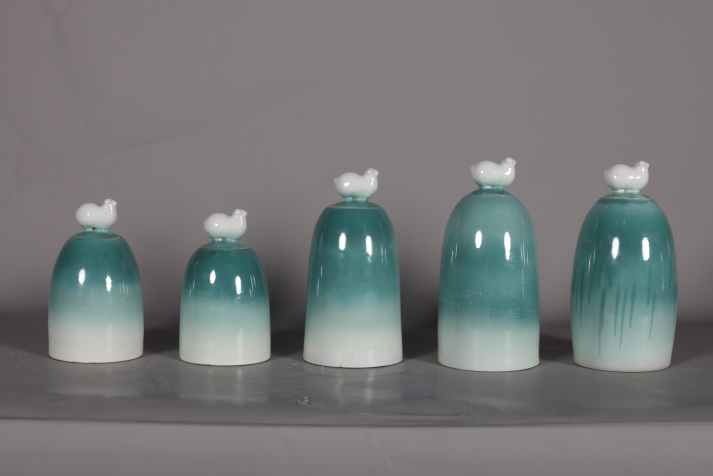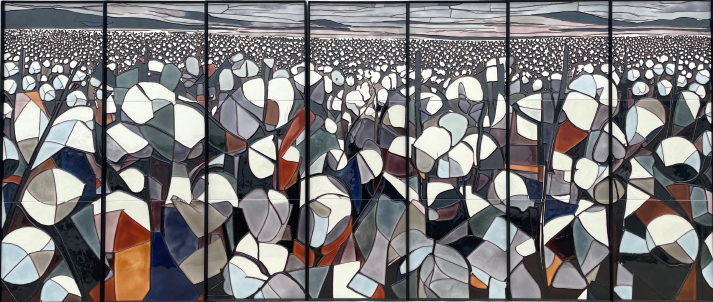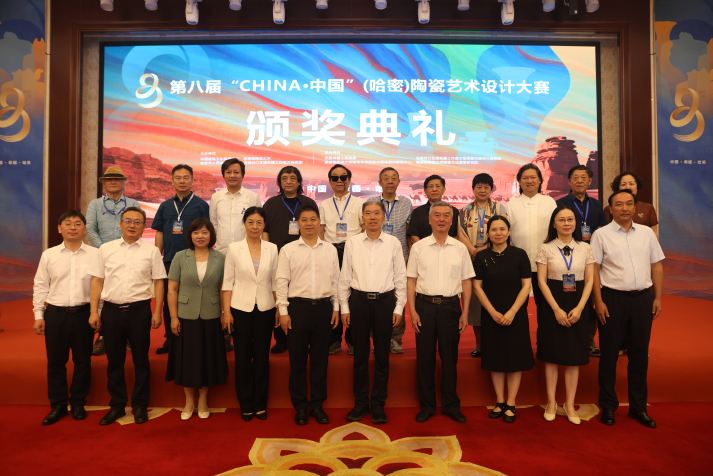| Xinjiang Today |
| When clay becomes culture | |
|
|
 Ceramic creations that won awards at the Eighth China Ceramic Art Design Competition (COURTESY PHOTO)
Balikun (Barkol) Kazak Autonomous County in Hami City, lying at the foot of the Tianshan Mountains in northeast Xinjiang, is a key border trade port between Xinjiang and Mongolia. Today, it has added a new feather in its cap, filling a long gap in Xinjiang's resources. It is now the cradle of Xinjiang New Porcelain, the fruit of the fusion of two worlds' features—the craftsmanship of China's Central Plains and Western Region aesthetics, opening a new window for the world to understand Xinjiang.
The Central Plains, primarily comprising the lower and middle reaches of the Yellow River, are regarded as the cradle of Chinese civilization and have a history of being the center of cultural and economic activities. In ancient China, Xinjiang was known as the Western Regions, as it is located west of the Central Plains. This story goes back to the autumn of 2023, when officials from Pingdingshan, Henan Province in central China, stationed in Xinjiang under an assistance program proposed a project—introducing porcelain making to Xinjiang. Though Xinjiang has rich porcelain clay reserves, it had never produced high-temperature porcelain. The plan therefore was to integrate the Central Plains' techniques with Xinjiang's clay. Under the Xinjiang assistance program, multiple provinces and municipalities directly under the administration of the Central Government are partnered with Xinjiang's prefectures to help boost development in the region.  A prize-winning Xinjiang New Porcelain artwork (COURTESY PHOTO)
Mission ceramics Pingdingshan University in Henan spearheaded this cultural mission. Mei Guojian, Dean of its School of Ceramics, mobilized over 180 faculty members and students to research diverse porcelain traditions and Xinjiang's clay type. Twenty-six enterprises joined this cross-regional effort, and after dozens of field surveys, they finally created over 1,000 porcelain items, crystallizing Xinjiang's multiethnic culture and filling its ceramic void. According to Mei, to make Xinjiang New Porcelain, they use locally sourced clay and glazes, fired at 1,250-1,300 degrees Celsius. "This breakthrough has not only given Xinjiang its own ceramic tableware but also enabled users to experience Chinese cultural heritage, fostering cultural identity," Mei said. According to Qi Zhe, Dean of the School of Arts and Crafts at the Guangzhou Academy of Fine Arts, the value of Xinjiang New Porcelain lies not just in technical innovation, but in providing the region's cultural diversity with contemporary artistic expression: "The natural textures in its glazes and cultural symbols in its forms aren't mere decorative elements—they represent the creative integration of tradition and modernity. This fusion turns ceramics into a cross-cultural 'language,' offering a dynamic vehicle for cultural enrichment in Xinjiang."  The Eighth China Ceramic Art Design Competition award ceremony is held in Hami on August 1 (COURTESY PHOTO)
Magnificent Xinjiang The China Ceramic Art Design Competition is a premier event in ceramic arts. This year, its eighth edition had Magnificent Xinjiang as its creative theme and core design element. The aim was to emphasize novel perspectives, innovative concepts and creativity while highlighting cultural exchange, mutual learning among civilizations and ethnic unity. It garnered widespread attention, attracting enthusiastic participation from students and the faculty of domestic and international universities, ceramic professionals from research institutions and enterprises, as well as cross-disciplinary designers. Over 3,000 ceramic art and design works were submitted globally. A dedicated Xinjiang New Porcelain section was established for this edition. The competition showcased the cultural heritage, ethnic traditions, natural landscapes and distinctive products of Magnificent Xinjiang. The award ceremony was held in Hami in August, co-hosted by the Hami Municipal People's Government, the China Building Ceramic and Sanitary Ware Association and other organizations. The ceramic work Portrait of Lord Zuo won the Xinjiang New Porcelain Design Gold Prize. The statuette depicts Zuo Zongtang, the Qing Dynasty (1644-1911) official renowned for his heroic feat of reclaiming and developing Xinjiang. Zuo holds a sheathed sword that conveys dignity and solemnity, while the scholarly scrolls behind him symbolize strategic wisdom. It was created by Fan Suizhou, who has been recognized as an inheritor of Ru ware, a highly prized and extremely rare type of pottery made in Henan for the imperial court in the Northern Song Dynasty (960-1127). The statuette was made in Balikun. Chen Hanqing, a professor with the School of Art and Design at the Wuhan University of Technology, pointed out that Xinjiang New Porcelain not only inherits traditional ceramic strengths but also integrates Xinjiang's local industries and ethnic cultures. "Its glaze designs incorporate natural elements like the crimson of volcanoes and golden yellow of the Gobi Desert, while the forms are cultural symbols. It vividly demonstrates the integrated development of all ethnic groups," Chen said. Shared bonds The competition organizing committee presented the Hami Municipal People's Government a porcelain plaque artwork, Qing Dynasty Map of Hami. Jointly created by a Zhejiang University team led by Professor Zhou Shaohua and Lin Tieng-jen, a researcher at the Palace Museum in Taipei, it is the replica of an ancient map from the museum's collection using contemporary porcelain plaque techniques. It not only revives Hami's historical legacy but also stands as a testament to the shared cultural bonds across the Taiwan Straits. "Hami will use ceramic design to promote the inheritance and innovation of China's outstanding traditional culture," Hami's Vice Mayor Hu Dongming said during the award ceremony. "We will further integrate ceramic art with local cultural distinctiveness to facilitate mutual learning among all ethnic groups, serving Xinjiang's overarching goals of social stability and long-term prosperity." At a forum on innovation in the ceramic industry and its development on August 1, Ma Xianghui, an official from Pingdingshan currently working in Balikun, said Balikun has established its ceramic industry from scratch by leveraging its porcelain clay resources and Henan's assistance programs. Cao Shenglong, a representative of the White Rabbit Ceramics Group in Zhuhai, Guangdong Province, said his company is committed to developing Balikun's porcelain clay. "While first addressing Xinjiang's local demand, we will gradually expand into Central Asia, the Middle East and neighboring markets," Cao said. Li Yafang, Associate Editor in Chief of China International Communications Group, explained how Xinjiang New Porcelain, a unique vehicle carrying Xinjiang's culture, possesses innate advantages for international communication. "Its stories of Xinjiang and China—expressed through clay—blend regional character with the spirit of community. Through global communication channels, the world can perceive Xinjiang's cultural vitality and progress via these ceramics, making Xinjiang New Porcelain a new cultural bridge between China and the world," she said. Comments to ffli@cicgamericas.com |
|
||||||||||||||||||||||||||||
|